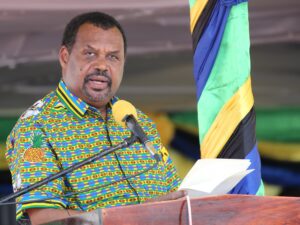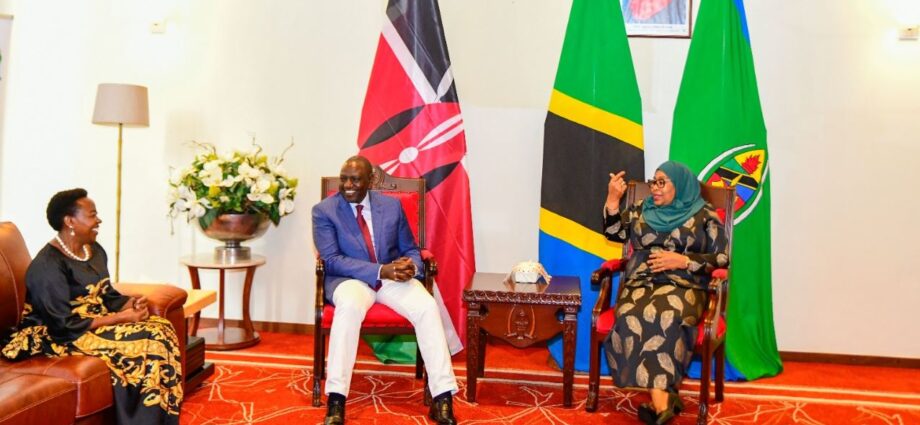POMP and fanfare greeted the arrival of Kenyan President William Ruto as he landed at Julius Nyerere International Airport (JNIA), on Sunday for bilateral talks with his host President Samia Suluhu Hassan in what could further bolster socio-economic ties between Dar es Salaam and Nairobi.
It is Ruto’s first ever state visit to Tanzania since he took the oath of office last month, after he received an invitation from President Samia.
The new Kenyan leader was received at the JNIA by the Minister for Foreign Affairs and East African Cooperation, Dr Stergomena Tax.
Dr Ruto was accompanied by a delegation of officials and his wife Rachel Ruto.
Today, the two leaders are scheduled to hold an official meeting at the Magogoni State House in Dar es Salaam.
According to a statement issued yesterday by the Ministry for Foreign Affairs and East African Cooperation, after their meeting the two leaders will hold a news conference and later Dr Ruto and his delegation will be treated at a state banquet to be hosted in his honour by President Samia.
President Ruto has so far made four foreign visits since taking over office. His first trip was to the United Kingdom where he joined other world leaders at the burial of Queen Elizabeth II.
After the trip in the UK, he flew to the United States to attend the 77th session of the United Nation’s General Assembly (UNGA) which opened on September 13, this year. He was yesterday in Uganda to attend that country’s 60th independence celebrations.
His visit in Tanzania is expected to boost trade between the two neighbouring countries which are also members of the East African Community (EAC).
Trade between Tanzania and Kenya is the highest in EAC, fuelled by continued strong trade ties between the two countries as non-tariff trade barriers (NTBs) which previously hindered cross-border trade continue to be removed.
The visit by President Ruto also signals the growing bilateral relations in various sectors of the economy between the two countries.
Shortly after President Ruto was announced the winner in the presidential election which was held on August 9, this year, President Samia made a commitment to continue collaborating with Kenya in bringing social and economic development to their respective countries.
She later sent a congratulatory message to the Kenyan leader when his election was upheld by the Supreme Court of Kenya.
“I’m looking forward to working with you to strengthen the historic bond and cooperation between our two nations,” President Samia wrote on her official twitter account.
In an earlier message on her account when Dr Ruto was announced the winner by Kenya’s Independent Electoral and Boundaries Commission (IEBC), Ms Samia twetted; “I congratulate the people of Kenya on their peaceful general election and the subsequent announcement of Dr@WilliamsRuto as President-elect.
Adding; “We look forward to continuing working together with our brothers and sisters in Kenya to strengthen our historically close ties. Tuko Pamoja (we are together),” President Samia tweeted.
Tanzania is the second country among the seven member states of the EAC to be visited by President Ruto since he took over office. Other members of the regional bloc include Uganda, Rwanda, Burundi, South Sudan and the Democratic Republic of Congo (DRC).
The Kenyan leader also told President Samia that his government is committed to improve relations with Tanzania on trade, agriculture, security, and other sectors.
Mr Ruto made the pledge during a meeting between the two leaders at the State House in Nairobi when she travelled to that country to attend the swearing-in ceremony of the former.
President Samia had earlier visited Kenya last year, a few months after assuming power. The visit focused on various issues including trade, economic and social issues.
Source: allafrica.com
Share this news
This Years Most Read News Stories

How new crop insurance will change farmers’ fortunes
Initiative is a shot in the arm for agriculture, which is currently virtually uninsured with just 0.17 percent of all general insurance sales.Continue Reading

ZSSF money not for projects, says Ali Karume
Unguja. Veteran politician and diplomat Ali Karume has called on authorities of the Zanzibar Revolutionary Government (SMZ) to refrain from using the Zanzibar Social Security Fund money for establishing commercial projects.Continue Reading

Zanzibar Airport Authority to audit ground handlers
Unguja. The Zanzibar Airports Authority (ZAA) is set to conduct an audit on ground handling companies that currently operate at the Abeid Amani Karume Airport with effect from Monday. The week-long audit is set to include Transworld, ZAT and the newcomer Dnata Zanzibar who were licensed in June plus exclusive rights to manage Terminal 3 building by ZAA.Continue Reading











